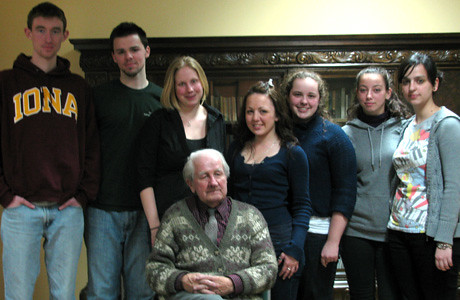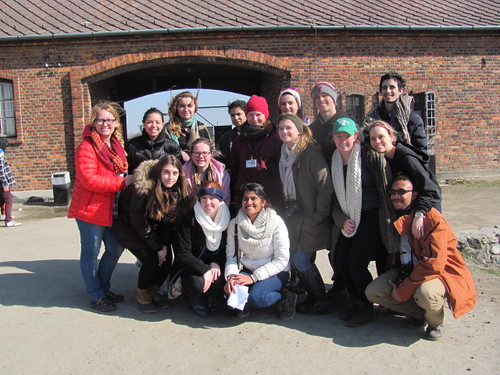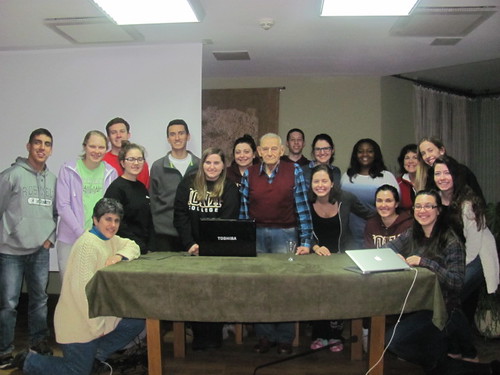It was during our first trip to Auschwitz
(I) that I realized that such a large part of the Holocaust relates to the
dehumanization of its victims. One of the first concepts we discussed in this
class was the Teaching of Contempt – a Christian curriculum designed to shame
followers of the Jewish faith through classifying them as degenerative
murderers of God Himself. During this lesson, we were asked to analyze various influential
Early-Christian texts, one of which being John Chrysostom’s Homily 1: Against the Jews. It is in
this text that the Archbishop preaches to his followers the dangers of the
Jews, referring to their religion as a disease and to them as demons and beasts.
Flash forward a millennium and such dehumanizing tactics are still being used
today, albeit in a less harsh manner. This time in the form of numbers, the
victims of the Holocaust are constantly being associated with/referred to as
statistics, rather than humans.
 |
| Barracks at Auschwitz I |
Whether it is the dates that events began
or ended, the amount of calories consumed per day, the death toll, or even the
prisoners of the concentration and extermination camps themselves, numbers play
a vital role in the understanding of the Holocaust. In fact, statistics are used
as a means of putting this tragedy into a somewhat more fathomable perspective.
However, numbers and the Holocaust an adverse history as well. The Nazis would
be given a certain number of people kill, and they would
achieve that goal by any means necessary. Prisoners would be assigned a number upon arriving at the Auschwitz
camps, and would thenceforth be referred to solely by those digits. At roll
call, S.S. Guards would count to make sure that the proper number of prisoners were in attendance. In the mind of the
Holocaust perpetrators, there were no people, just quotas – or rather, numbers.
Unfortunately, a similar mindset can be found today. With the Holocaust
curriculum being comprised largely of the numbers associated with it, many are
finding it increasingly more difficult to differentiate these statistics from
the people they are being applied to, as they are being taught to look at the
numbers, rather than the people themselves.
 |
| Prisoner Uniforms Lined Up |
Prior to attending this trip, almost
everything I knew about the Holocaust was in the form of a number. When my
education of the Holocaust first began, I was taught that the years 1933-1945 were filled with unimaginable
horrors, that during this time millions
of lives were ruthlessly taken. While a day or two was spent discussing who
these lives once belonged to (Jews, homosexuals, Gypsies, etc.), a greater
emphasis was still being placed on the number
of people killed rather than the people
themselves. My teacher did not say “Jews were murdered,” but rather “six million Jews were murdered.” Every
fact we learned either started in or ended with some arrangement of digits. Did
this prevent me from being able to see that this was a horrible period in time?
Of course not. However, it did inhibit my understanding of the significance of
the Holocaust and the importance behind studying it. As a result, I never
considered to look past the numbers, or to even consider why the numbers were
what they were. I simply accepted them.
 |
| Assorted Cookware Brought by Prisoners to Auschwitz I |
It was only after taking this class and traveling
to Poland that I began to view the Holocaust and its victims through a
different perspective. During our first night in Poland, we were lectured by
Father Manfred – an established scholar of the Holocaust. It was during this
lecture that Father Manfred discussed the importance of the victims of the Holocaust,
and how by connecting with them – by putting ourselves in their mind – we are
able to get a glimpse at what the Holocaust was, as well as how such a tragedy
could occur. In other words, in order to understand the Holocaust, we must
first care about the victims. In order to do that, however, it is essential
that we saw them as human beings, not just statistics. This idea is something
that I kept in the back of my mind when we visited the camps. Being brought
through the barracks that once contained prisoners, seeing what their living
conditions were like, and learning about how they all brought their possessions
from home under the impression that they would someday return, made something
click. Statistics did not live in these prison cells. Numbers did not starve. It
was humans who were hanged by their hands just inches above the ground, humans who
were forced to walk to the gas chambers, humans whose ashes once covered this
camp. Only by making this connection were my eyes finally opened to the
Holocaust in its entirety.
 |
| Guard Tower and Warning Sign at Auschwitz I |
To discuss the events that took place
during the Holocaust without numbers, would be a gross injustice. However, while
it is incredibly important to learn about these numbers, it is also essential
to differentiate them from the people they are associated with. If this distinction
fails to be made, we risk dehumanizing those who were murdered, therefore
distancing ourselves from the severity of the Holocaust and preventing the
magnitude of this event from fully being recognized.

































